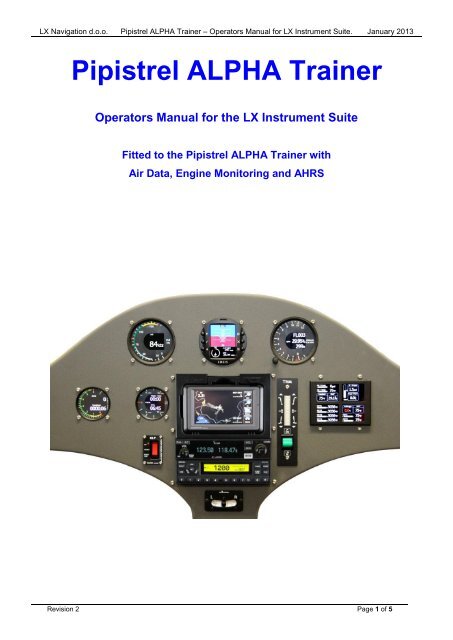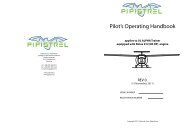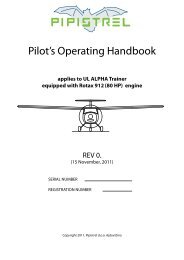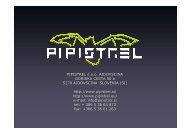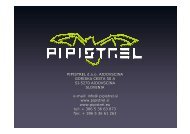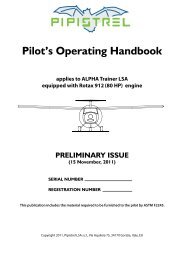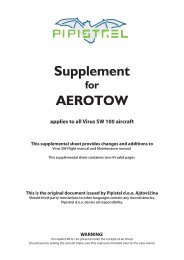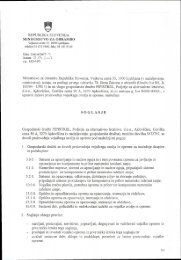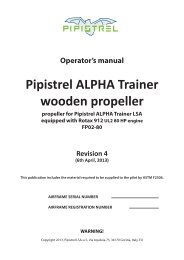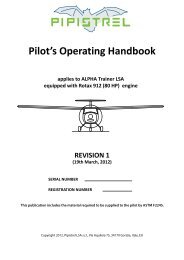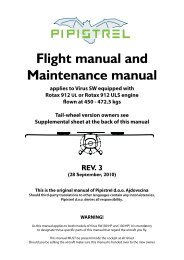ALPHA Trainer LX Manual.pdf - Pipistrel
ALPHA Trainer LX Manual.pdf - Pipistrel
ALPHA Trainer LX Manual.pdf - Pipistrel
Create successful ePaper yourself
Turn your PDF publications into a flip-book with our unique Google optimized e-Paper software.
<strong>LX</strong> Navigation d.o.o. <strong>Pipistrel</strong> <strong>ALPHA</strong> <strong>Trainer</strong> – Operators <strong>Manual</strong> for <strong>LX</strong> Instrument Suite. January 2013<br />
<strong>Pipistrel</strong> <strong>ALPHA</strong> <strong>Trainer</strong><br />
Operators <strong>Manual</strong> for the <strong>LX</strong> Instrument Suite<br />
Fitted to the <strong>Pipistrel</strong> <strong>ALPHA</strong> <strong>Trainer</strong> with<br />
Air Data, Engine Monitoring and AHRS<br />
Revision 2 Page 1 of 5
<strong>LX</strong> Navigation d.o.o. <strong>Pipistrel</strong> <strong>ALPHA</strong> <strong>Trainer</strong> – Operators <strong>Manual</strong> for <strong>LX</strong> Instrument Suite. January 2013<br />
<strong>ALPHA</strong> <strong>Trainer</strong> Panel Layout<br />
EMSIS AHRS<br />
IAS Indicator<br />
Altimeter<br />
Variometer<br />
Tachometer<br />
Engine Data Display<br />
Revision 2 Page 2 of 5
<strong>LX</strong> Navigation d.o.o. <strong>Pipistrel</strong> <strong>ALPHA</strong> <strong>Trainer</strong> – Operators <strong>Manual</strong> for <strong>LX</strong> Instrument Suite. January 2013<br />
System description<br />
The <strong>LX</strong> Navigation Instrument system consists of following instruments:<br />
• EMSIS AHRS - 80 mm (3⅛”) unit with artificial horizon and air data source;<br />
• DAQU engine monitoring box (mounted behind instrument panel);<br />
• <strong>LX</strong> Cluster engine data display;<br />
• IAS indicator - 80 mm (3⅛”);<br />
• Altimeter - 80 mm (3⅛”);<br />
• Variometer - 57 mm (2¼”);<br />
• RPM and hour meter - 57 mm (2¼”).<br />
All instruments are electronic devices connected to the main system electrical bus. They have a<br />
familiar needle display recognized immediately by older pilots as well as large digital numbers<br />
which are easy to read in all conditions. The only unit which is connected to the airplane pitot<br />
and static source is EMSIS AHRS.<br />
1 EMSIS AHRS<br />
The EMSIS AHRS is a 80 mm (3⅛”) instrument<br />
and is the central part of the <strong>LX</strong> instrument system;<br />
it and the other instruments turn on immediately<br />
after main power is applied.<br />
The display is divided into three parts, the upper<br />
part displays your track heading (derived from<br />
inbuilt GPS) the larger middle section is an artificial<br />
horizon indicator and the lower part shows IAS,<br />
altitude and QNH.<br />
QNH always matches the value which is set on the<br />
altimeter. The altimeter has the QNH adjustment<br />
knob which is shared between both instruments.<br />
Description of commands:<br />
• Long press on pitch zeroing;<br />
• Short press on increasing of backlight;<br />
• Short press on decreasing of backlight;<br />
• Micro SD slot for future updates.<br />
Safety Instructions!<br />
Keep the unit powered during flight, otherwise engine data and air data<br />
Will be lost from the displays until power is re-applied.<br />
Revision 2 Page 3 of 5
<strong>LX</strong> Navigation d.o.o. <strong>Pipistrel</strong> <strong>ALPHA</strong> <strong>Trainer</strong> – Operators <strong>Manual</strong> for <strong>LX</strong> Instrument Suite. January 2013<br />
2 IAS Indicator<br />
The IAS instrument is a 80 mm (3⅛”) unit which consists of<br />
a familiar mechanical needle and a large OLED digital<br />
display. Both the needle display and the digital indicator<br />
show the indicated airspeed in knots. Green, yellow and<br />
white bars indicate the different airspeed limitations.<br />
Never exceed (VNE) which is clearly marked with the red<br />
line.<br />
3 Altimeter<br />
The altimeter is a 80 mm (3⅛”) unit which shows aircraft<br />
altitude based on QNH.<br />
The altimeter consists of familiar mechanical needle which<br />
shows the altitude from zero up to 12000 feet.<br />
The large OLED digital display shows altitude in feet, FL<br />
(flight level) and QNH in InHg. The QNH is adjusted by<br />
rotating the knob as shown in the picture. This knob also<br />
adjusts the QNH on the EMSIS instrument.<br />
4 Variometer<br />
QNH adjustment knob<br />
The variometer is a 57 mm (2¼”) unit and consists of a<br />
familiar needle and OLED digital display. The needle shows<br />
if the aircraft is climbing or descending.<br />
The scale is calibrated from 0 up to ± 2000 ft/min.<br />
The large OLED digital display shows:<br />
• Flight time;<br />
• UTC.<br />
Note: There are no adjustments on this instrument by the<br />
pilot. UTC time is obtained through GPS signal, flight time<br />
resets to zero after each flight.<br />
Revision 2 Page 4 of 5
<strong>LX</strong> Navigation d.o.o. <strong>Pipistrel</strong> <strong>ALPHA</strong> <strong>Trainer</strong> – Operators <strong>Manual</strong> for <strong>LX</strong> Instrument Suite. January 2013<br />
5 <strong>LX</strong> Cluster Engine Data Display<br />
The <strong>LX</strong> Cluster Engine Data Display is used for<br />
monitoring the engine operating parameters. The only<br />
exception is fuel tank indicator which indicates fuel tank<br />
status in percentage fuel remaining ranging from - 0%<br />
(empty) up to 100% (full). Most indicators have<br />
multicolored bars to show the preferred operating<br />
temperature. The red bar defines the out of limit status<br />
and exceeds the Rotax recommended limitations. The <strong>LX</strong><br />
engine data display shows most settings with colored<br />
bars and digital numbers.<br />
The <strong>LX</strong> Cluster Engine Data instrument displays the following readings….<br />
• Oil pressure;<br />
• Fuel pressure;<br />
• Oil temperature;<br />
• Instant fuel flow;<br />
• Water temperature;<br />
• Fuel % remaining;<br />
• Manifold pressure;<br />
• Bus voltage;<br />
• CHT – 1 & 2;<br />
• Outside air temperature.<br />
• EGT – 1, 2, 3 & 4;<br />
6 RPM Meter - Tacho<br />
The RPM indicator is a 57 mm (2¼”) unit which displays the<br />
current engine revolutions with both a familiar mechanical<br />
needle as well as a large OLED digital display.<br />
Color arcs display the operating limitations of the Rotax 912<br />
UL2 engine. The Tacho also includes the Hobbs Hour<br />
meter.<br />
| End of Document |<br />
Revision 2 Page 5 of 5


